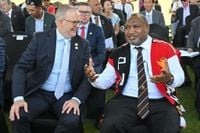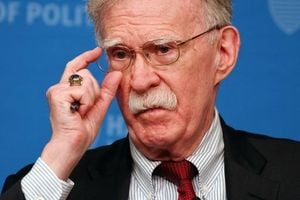Australia and Papua New Guinea are poised to enter a new era of strategic partnership as their leaders prepare to sign the landmark Pukpuk mutual defence treaty, a move that analysts say will reshape security dynamics in the Pacific. The agreement, expected to be inked as early as Monday, October 6, 2025, follows Papua New Guinea’s Cabinet approval and comes after Prime Minister Anthony Albanese and his Papua New Guinean counterpart, James Marape, attended the NRL grand final in Sydney. For both nations, the treaty marks a historic step, elevating their relationship to a formal alliance and signaling a renewed commitment to regional security amid intensifying geopolitical competition.
The Pukpuk agreement—named after the Tok Pisin word for crocodile, a symbol of strength and resilience in PNG—requires each country to come to the other’s aid in the event of a military attack. It also establishes a pathway for citizens of each nation to serve in the other’s defence force, a first in Australia’s modern defence history since the ANZUS treaty was signed in 1951. According to the Australian Associated Press, this will be only the second such alliance for Australia, making Papua New Guinea its third treaty ally.
Prime Minister Marape underscored the significance of the pact, stating in a formal announcement, “Australia has only one other mutual defense treaty of this type and at our request Papua New Guinea will now sign this treaty.” He added, “This reflects the depth of trust, history, and shared future between our two nations,” as reported by the Associated Press. Albanese echoed these sentiments, emphasizing, “Our two nations are the closest of neighbors and the closest of friends, and this treaty will elevate our relationship to a formal alliance.”
The agreement comes at a time of mounting strategic competition in the Pacific, with China’s growing influence prompting the United States and Australia to deepen military ties with island nations. Australia’s move to formalize its alliance with PNG is widely seen as a response to China’s 2022 security deal with the Solomon Islands, which raised concerns about the prospect of a Chinese naval base in the South Pacific. As Oliver Nobetau, project director of the Australia–Papua New Guinea Network at the Lowy Institute, told the Australian Broadcasting Corporation, “By ensuring you protect PNG’s security, you protect Australia’s security as well.”
For Papua New Guinea, a nation of roughly 10 to 15 million people with a defence force of about 4,000 to 5,000, the treaty is both a strategic and practical opportunity. The pact allows up to 10,000 Papua New Guinean citizens to serve in the Australian Defence Force, potentially addressing Australia’s longstanding recruitment shortfall and offering PNG citizens a pathway to Australian citizenship. This provision has been described by Nobetau as “a really equal deal, in terms of creating the opportunity for 10,000 citizens to serve in the Australian Defence Force. Nobody else can do that.”
The treaty’s core principles were jointly affirmed by Marape and Albanese in a statement earlier this year, which declared: “An armed attack on Australia or Papua New Guinea would be a danger to the peace and security of both countries.” This mutual commitment not only strengthens deterrence but also formalizes a level of military integration unprecedented in the region, vastly increasing the interoperability of equipment and personnel between the two nations, according to the Associated Press.
However, the treaty’s implications extend beyond defence cooperation. Australia’s willingness to shoulder greater security responsibilities in the Pacific comes with financial obligations. The Albanese government has faced calls—particularly from the Trump administration in the United States—to raise defence spending to 3.5% of gross domestic product. While David Andrews, a senior policy advisor at the ANU National Security College, dismissed the US argument as “completely wrong,” he acknowledged that increased spending is necessary. “We should be increasing defence spending, not because Donald Trump has asked for it but because we have more defence obligations that are unique to Australia,” Andrews told the Australian Associated Press. He added, “Those are only increasing with this treaty and security relationships that we’re upgrading throughout the Pacific. You’ve got to match your words with actions.”
For Australia, the alliance with PNG is also about shoring up its influence in a region where diplomatic allegiances have shifted rapidly. Since 2019, three Pacific island nations have switched diplomatic recognition from Taiwan to Beijing, and China has ramped up police training and security cooperation with countries like Fiji, Kiribati, Samoa, Solomon Islands, and Vanuatu. The United States and its allies, including Australia, see PNG as a strategically vital partner in countering China’s ambitions in the Pacific.
Yet the new alliance is not without controversy. China’s embassy in Port Moresby criticized the leaders’ joint statement, cautioning that such a bilateral treaty “should not be exclusive in nature, nor should it restrict or prevent a sovereign country from cooperating with a third party for any reason.” The embassy further warned, “It should also refrain from targeting any third party or undermining its legitimate rights and interests.” This reaction highlights the delicate balancing act facing Papua New Guinea, which is eager to deepen security ties with Australia and its Western allies while maintaining robust economic relations with China.
Nobetau noted this tension, saying, “The Papua New Guinea government, especially James Marape, has come out and demarcated how they see the bilateral relationships moving forward: now with the security space, siding with Australia’s traditional Western allies. And definitely in the economic and trade space, building up that relationship with China.” The dual-track approach reflects PNG’s pragmatic strategy to maximize benefits from both partnerships without alienating either major power.
The process leading up to the treaty’s signing has not been without hiccups. Marape and Albanese had initially hoped to sign the pact at a ceremony in Port Moresby on September 17, 2025. However, the event was delayed when a key Cabinet meeting to endorse the agreement did not take place. Instead, the two leaders signed a joint statement affirming the treaty’s core principles, paving the way for the final agreement to be signed in October.
As the region watches closely, the Pukpuk treaty stands as a testament to the evolving security landscape of the Pacific. It’s a bold move by both nations—one that underscores their shared history, mutual trust, and the challenges of navigating an increasingly complex strategic environment. With the ink set to dry on this historic pact, Australia and Papua New Guinea are making it clear: their destinies in the region are now more closely intertwined than ever before.




